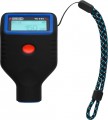Max. thickness (ferrous met.)
The maximum coating thickness that the instrument can detect when measuring on ferrous metals such as steel. With a larger coating thickness, the thickness gauge sensor simply cannot “catch” on the metal surface under the paint, and effective measurement will not be possible. This parameter is indicated in micrometers — thousandths of a millimetre; the larger it is, the more versatile the device is, the wider the possibilities for its use. On the other hand, a large maximum measurement thickness can adversely affect the accuracy when measuring small values.
For modern thickness gauges, the maximum thickness
up to 1000 microns is considered small,
from 1000 to 1500 microns — small,
from 1500 to 2000 microns — medium,
more than 2000 microns — significant. In the most advanced professional-level models, this figure can reach 20 – 30 cm.
Max. thickness (non-ferrous met.)
The maximum coating thickness that the instrument can detect when measuring non-ferrous metals such as aluminium alloys. With a larger coating thickness, the thickness gauge sensor simply cannot “catch” on the metal surface under the paint, and effective measurement will not be possible. This parameter is indicated in micrometers — thousandths of a millimetre; the larger it is, the more versatile the device is, the wider the possibilities for its use. On the other hand, a large maximum measurement thickness can adversely affect the accuracy when measuring small values.
For modern thickness gauges, the maximum thickness
up to 1000 microns is considered small,
from 1000 to 1500 microns — small,
from 1500 to 2000 microns — medium,
more than 2000 microns — significant. In the most advanced professional-level models, this figure can reach 20 – 30 cm.
Measurement speed
The rate of measurement provided by the instrument. Indicated by the time that elapses from the measurement command (for example, pressing the corresponding button) until the result is displayed on the display.
Even in the "slowest" modern thickness gauges, this parameter does not exceed two seconds. So it makes sense to pay attention to it, first of all, if time saving is of critical importance — for example, if it is planned to make measurements often and in large quantities, including in continuous metering mode (see below).
Max. error
The maximum measurement error provided by the device, in other words, the largest deviation from the real value of the measured value that may occur during the measurement process. The smaller this indicator, the more accurate the device, the smaller the error it gives in the measurement process; on the other hand, high accuracy has a corresponding effect on cost.
Specifically, in thickness gauges, an accuracy of 10% is considered low, 5% is average, 3% is good, and less than 3% is excellent.
Continuous measurement
Support of the device of a mode of
continuous measurement.
In this mode, the user does not need to press the button every time to take measurements — the device constantly scans the space and automatically displays the measurement results on each subsequent contact with the painted surface. This format is very convenient for large-scale work — for example, for a comprehensive check of the car body.
Auto switch-off
The presence in the device of the
automatic shutdown function: the device turns off on its own if the user has not performed any actions with it for some time. The response time for this function is usually a few minutes.
Auto-off saves battery power; it is especially useful if the user forgets to turn off the instrument manually.
Memory
The maximum number of measurement results that can be simultaneously stored in the instrument's built-in memory. This number can vary from 10 – 20 in low-cost models to several thousand in the most advanced ones.
Volumetric memory allows you to simultaneously store a lot of information, but affects the cost of the device.
Operating temperature
The temperature range at which the thickness gauge can normally perform its functions. If you go beyond this range, the device may not break down immediately, but you won’t have to talk about accurate measurements. Note that you have to pay attention to this parameter mainly in cases where the device is planned to be used outdoors. So, for use in winter, it is worth making sure that the device is able to operate at
temperatures below zero, and for hot climates, it is desirable that the upper limit of the range is
+40 °C and above.

